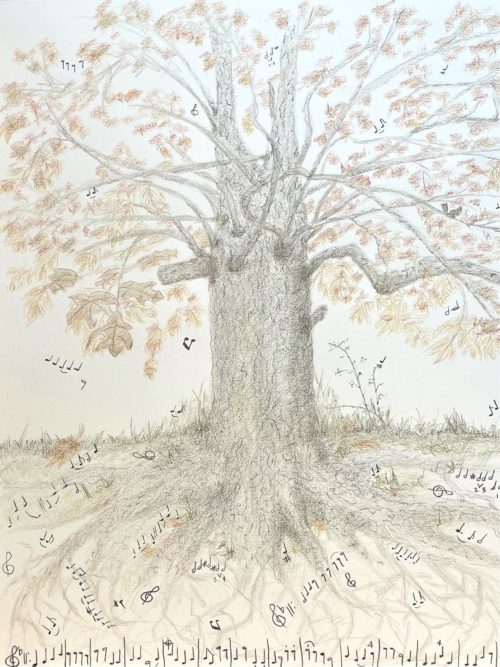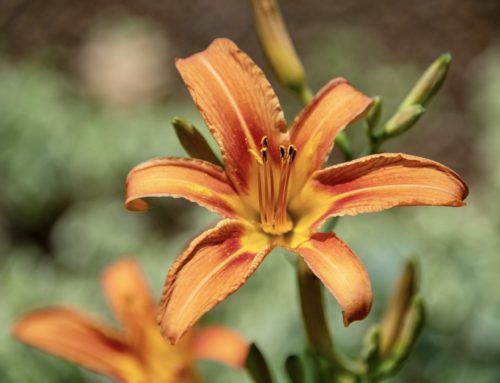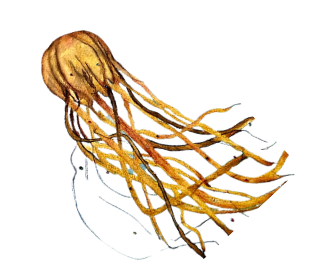Trees are an endless source of inspiration.
We have seasonal changes from deciduous trees and year-round beauty and energy from evergreens. There are nurturing protective mangroves, and fruit-bearing apples, pears, citrus, and fig. The decorative beauty of Japanese maples and cherry blossoms is unparalleled. Trees are powerful and magnificent, and I love to sketch and draw them.
Two books that speak to my fascination with trees and explore the healing and restorative powers of trees are the 2018 epic novel, The Overstory by Richard Powers, and the 2015 beloved nonfiction, The Hidden Life of Trees: What They Feel and How They Communicate by Peter Wohlleben.
Beyond the allure and beauty of majestic redwoods and cypress trees, giant oaks, hickories, and walnuts live an equally incredible world below the surface — what Wohlleben describes in his book as a “secret place” — the root system.
In The Singing Tree, a 14×17” colored pencil on paper, I transcribed the symbiotic relationship between tree roots and life by adding musical notes interspersed between the root networks. The musical notes drift up through the ground and tree limbs to fill the air with hope and peace. The partial musical score bordering the bottom of the art is Beethoven’s Ode to Joy.
I chose this musical work because it’s the first piece I learned to play on the violin, and it earned me a spot in the Pittsburgh All-City Orchestra when I was eleven years old. Also because of what the music represents.
Beethoven’s Ode to Joy represents freedom, hope, joy, peace, and solidarity. It transcends boundaries and conflicts.
Ode to Joy is the finale of Beethoven’s masterpiece, Ninth Symphony, known as, The Ninth. But there’s nothing simple about this mammoth symphony. And there’s nothing simple about the creative process either.
Applying musical notes to the roots and air breathe life into the art. Though when I began this piece, I wasn’t thinking about adding music.
The creative process is fluid, yet it has structure, like the trunk of a tree and its expanding limbs and leaves. Alternately, the creative journey is full of stops and starts, like how I started this piece more than a year ago, and how I’m back to work on it until it’s finished.
Creative energy is deeply personal. The Singing Tree is no exception.
This piece was influenced by the books I mentioned above, the spiral-bound music notebook from my youth, walks in the woods, the ever-growing strength of the tree in my front yard, and my creative thoughts and feelings.
The chopped-off top limbs in The Singing Tree represent the tragedy, struggles, and lives lost during the 2009 North American ice storm. Kentucky was the hardest hit — 500,000 people were without power and 35 people died.
But this oak tree, and most of the trees in the area, despite the stresses and fury of that storm, survived.
Trees are essential for all living things on this planet. They disperse oxygen and sequester carbon. They provide shade, buffer strong winds to protect coastal regions, they’re home to numerous animal and insect species. Trees store water, preserve soil and provide us fruits and grains to eat.
Trees and music are universal languages that we all understand. In The Singing Tree, I combined both with the hope to bond us together during these difficult times, when we need strength, love, and above all, peace amongst us.
***
The Singing Tree, 14 x 17”, colored pencil on paper. Unfinished.
All rights reserved. www.maureencberry.com









